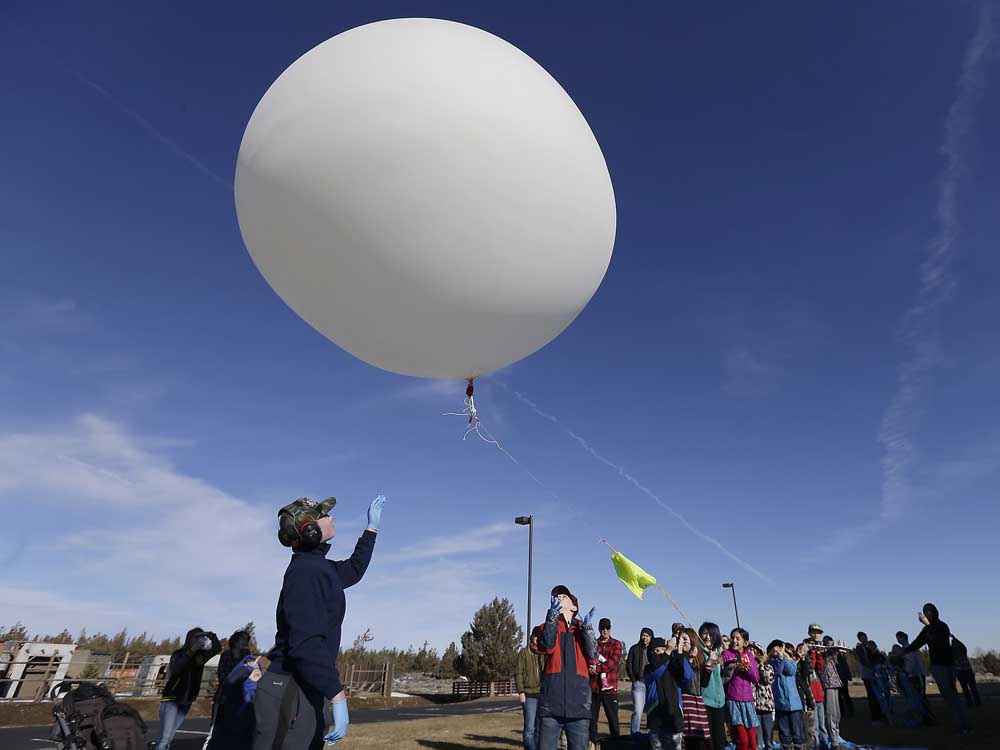Students launch high-altitude balloon into stratosphere
Published 12:00 am Saturday, March 23, 2019

- Landen Roggenkamp, 14, left, releases a high-altitude balloon Friday as fellow Bridge Charter Academy students help in the launch. (Ryan Brennecke/Bulletin photos)
A group of home-school students got to see the effects of low air-pressure and radiation after they sent a weather balloon into the stratosphere, with a little help from NASA.
High school and middle school students from the Bend campus of Bridge Charter Academy, with the assistance of University of Washington professor Robert Winglee, launched a high-altitude balloon nearly 100,000 feet into the sky Friday morning after pumping it full of helium. The intent of the event was to pique the students’ interest in space science.
Trending
“I think that it is inspirational for the students to see what a different world there is out there,” Winglee said before the event.
“It provides insight into opportunities for the next steps in their careers.”
Winglee, who teaches earth and space sciences, works with the Northwest Earth and Space Sciences Pipeline, an organization with the goal of bringing space science activities to underserved areas in the Pacific Northwest, outside of the Portland and Seattle regions. He said the program receives $2 million annually from NASA, and last year, Pipeline worked with 30,000 students across the region. For this trip, Winglee is working with students not only in Bend, but also in Yakima, Washington, and on the Burns Paiute Reservation.
“If we’re in Seattle and Portland, there’s major museums, interactions with high-tech companies,” Winglee said. “You’ve got more of that in Bend than in Yakima, but you still don’t have too much NASA science coming out your way.”
Annie Danaher, who teaches earth and space science labs for Bridge Charter Academy — a charter school sponsored by the Lowell School District that supports about 120 Central Oregon home-school students — agreed that Central Oregon children needed more space science experiment opportunities.
“In Central Oregon, things like this aren’t readily available,” she said. “Kids who might have an aptitude for science or space science, but have never been exposed to any direct experience, might then choose to move in that direction (after this experiment).”
Trending
Before the launch, Danaher said she and Winglee led classes on high-altitude balloons and the effects of high altitudes with the participating students. Students prepared the payload of items and the tin-foil reflector attached to the balloon. The payload included a measuring tool to check altitude, cameras to film the launch, and marshmallow Peeps, which will expand at high altitude. When the balloon goes to the stratosphere, the latex expands because of a lack of air pressure, freezes due to the extreme cold and pops, before floating back down to Earth with a parachute.
Danaher said the plan was for the balloon to land about 30 miles southeast of the launching site.
After the balloon launch, students participated in a few smaller space-themed activities: they chose from launching water rockets 150 yards into the sky, building kites out of newspapers and trash bags or designing paper airplanes.
Wingtree said he hopes the Bridge students, as well as other rural students who will launch his high-altitude balloons around the Northwest, will always remember the time they launched an object into the stratosphere.
“We don’t have to get them into space sciences; we just want them to see different things that you wouldn’t typically get in classroom science,” he said.
— Reporter: 541-617-7854, jhogan@bendbulletin.com








